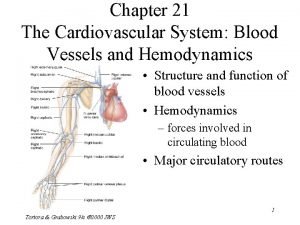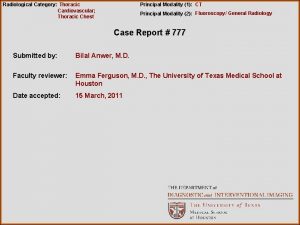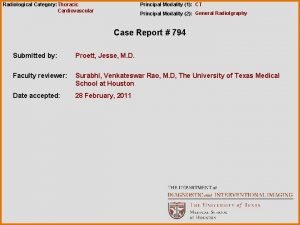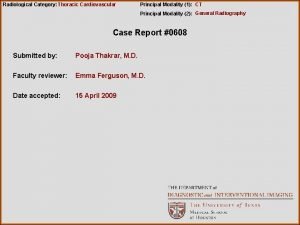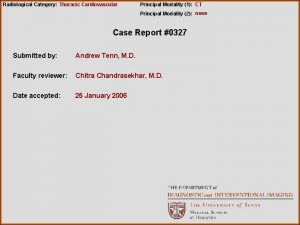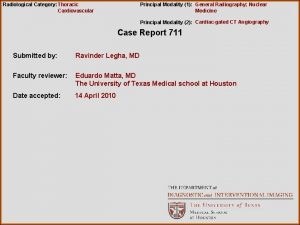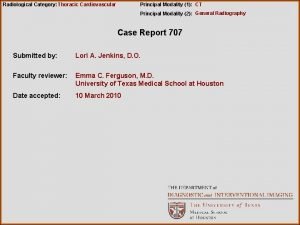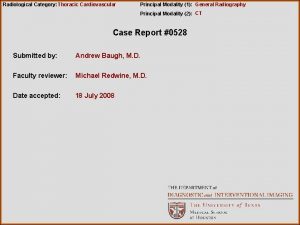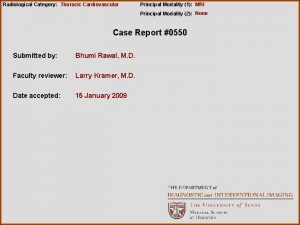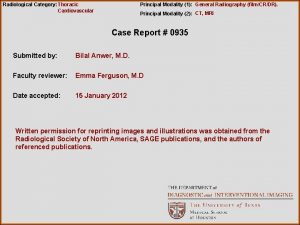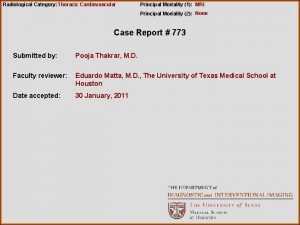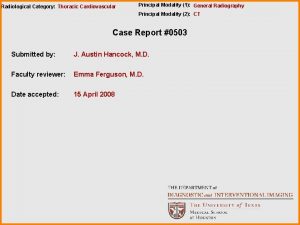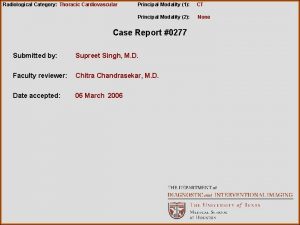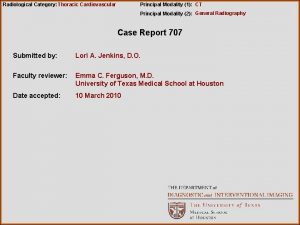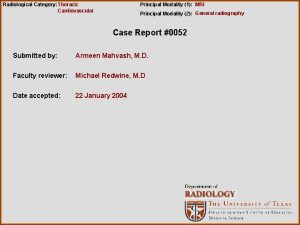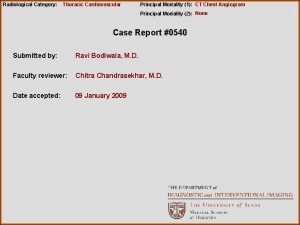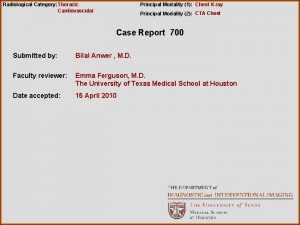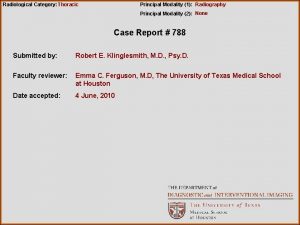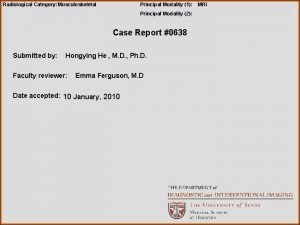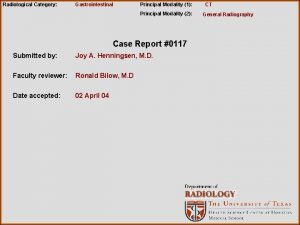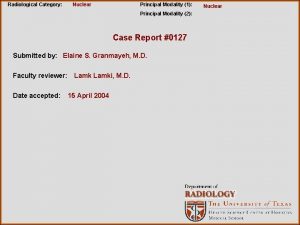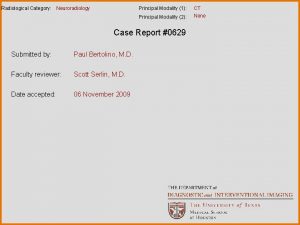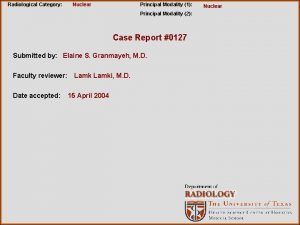Radiological Category Thoracic Cardiovascular Principal Modality 1 CT


























- Slides: 26

Radiological Category: Thoracic Cardiovascular Principal Modality (1): CT Principal Modality (2): X-ray Case Report # 0934 Submitted by: Haider Virani, M. D. Faculty reviewer: Varaha Tammisetti, M. D Date accepted: 12 March 2012

Case History 71 year old male with history of metastatic colorectal carcinoma presents with chemotherapy induced emesis and dehydration.

Radiological Presentations Aug 2011, frontal chest x-ray

Radiological Presentations Aug 2011, lateral chest x-ray

Test Your Diagnosis Which one of the following is your choice for the appropriate diagnosis? After your selection, go to next page. • Pulmonary arterial hypertension • Pulmonic valve stenosis • Primary lung malignancy • Hilar lymphadenopathy • Pericardial cyst • Anterior mediastinal mass • Left ventricular aneurysm • Left sided Pericardial defect

Radiological Presentations Jan 2010, contrast enhanced axial CT

Radiological Presentations Jan 2010, contrast enhanced axial CT

Radiological Presentations Jan 2010, contrast enhanced axial CT

Findings and Differentials Findings: Chest x-ray: Heart is slightly shifted to left and abuts the left chest wall. There is a left hilar contour abnormality with hilum overlay. In addition, a right hilar contour abnormality is identified. Right port-a-cath is noted. CT: There is levo and posterior rotation of the heart and also levoposition of the heart. A portion of lung is interposed between the aorta and main pulmonary trunk. The main pulmonary trunk and right pulmonary artery are dilated. Differentials: • Pulmonary arterial hypertension • Pulmonic valve stenosis • Primary lung malignancy • Hilar lymphadenopathy • Pericardial cyst • Anterior mediastinal mass • Left ventricular aneurysm • Left sided Pericardial defect

Radiological Presentations Enlarged right main pulmonary artery Enlarged pulmonary trunk Elongated silhouette abutting the left chest wall Leftward shift of heart Aug 2011, frontal chest x-ray

Radiological Presentations Enlarged right main pulmonary artery Enlarged pulmonary trunk Posterior rotation of the heart (no splaying of carina on frontal view) Inferior vena cava Aug 2011, lateral chest x-ray

Radiological Presentations Levoposition and levorotation of heart Jan 2010, contrast enhanced axial CT

Radiological Presentations Dilated pulmonary trunk Jan 2010, contrast enhanced axial CT

Radiological Presentations Interposed lung between aorta and dilated pulmonary trunk Jan 2010, contrast enhanced axial CT

Differential Diagnosis Pulmonary arterial hypertension demonstrates dilated central pulmonary arteries with quick pruning of peripheral pulmonary arteries. In early stages the heart size is normal, but in chronic cases right ventricular hypertrophy is present. Levoposition and levo- and posterior rotation the heart is not typically seen. Pulmonic valve stenosis demonstrates prominent main pulmonary trunk segment and dilated left main pulmonary artery. The right main pulmonary artery is not dilated. The heart position is typically normal. Presentation at this age is not expected. Pulmonic valve stenosis. Enlarged main pulmonary trunk and left pulmonary artery with normal heart position and size. (Radiopaedia. org) Pulmonary arterial hypertension. Dilated central pulmonary arteries with normal heart position and size.

Differential Diagnosis Primary lung malignancy can occur anywhere in the lung and does not typically affect the size of the pulmonary arteries or position of the heart. Hilar lymphadenopathy has a lobulated appearance and demonstrates the “hilum overlay” sign. There would be no dilatation of the pulmonary trunk or main pulmonary arteries. The position of the heart is normal. Hilar lymphadenopathy in Sarcoidosis. Bilateral hilar fullness proved to be lymphadenopathy on CT scan. (Radiopaedia. org) Primary lung malignancy. Round mass in lingula of left upper lobe. (Radiopaedia. org)

Differential Diagnosis Pericardial cyst are congenital structures implanted on the pericardium that do not communicate with the pericardial cavity. Most occur in the cardiophrenic sulcus and are located on the right. Pulmonary artery size and heart position are normal. Pericardial cyst. Round mass at right cardiophrenic sulcus on xray. Round mass with fluid attenuation on CT. (Radiopaedia. org) Anterior mediastinal mass is suggested on x-ray when there is no obscuration of the hilar vessels and descending aorta by the mass. The differential diagnosis includes thymoma, teratoma, lymphoma, and thyroid masses. Levoposition or enlarged pulmonary vessels are not seen. Anterior mediastinal mass. The x-ray is underpenetrated, but a mass occupies the left mid-lung. On CT, an anterior mediastinal mass with fat, calcium, and soft tissue components is identified. There is no enlarged pulmonary vessels or levoposition or levorotation of the heart. (Radiopaedia. org)

Differential Diagnosis Left ventricular aneurysm occur in myocardium that has undergone transmural infarction. A myocardial protrusion, sometimes calcified, will be seen on imaging. Although the cardiomediastinal silhoutte is enlarged due to extension by the ventricular aneurysm, there is no leftward shift or rotation of the heart. Additionally, the pulmonary artery size is not enlarged. Left ventricular aneurysm. A calcified protrusion is identified on x-ray that is anterior to the region of the left ventricle. CT demonstrates a left ventricular aneurysm. (Radiopaedia. org)

Discussion Congenital Absence of the Pericardium (CAP), more specifically a left sided congential pericardial defect. CAP Anatomy of the pericardium The normal pericardium is composed of two layers, an inner serous layer and an outer fibrous layer. The inner layer is the visceral pericardium and it adheres to the underlying epicardial fat and myocardium. At the boundaries of the heart the visceral pericardium reflects to become the inner lining of the outer fibrous layer and is called the parietal pericardium. The cavity between the parietal and visceral pericardium contains approximately 50 milliliters of fluid. Functionally, the inelasticity of the pericardium limits acute dilatation, but gradual dilatation can occur over the long term. Thin curvilinear structure with low signal intensity surrounded by high signal intensity epicardial and mediastinal fat is normal pericardium on T 1 weighted fast spin echo images. Bogaert, et al. Used with permission of copyright owner.

Discussion CAP Epidemiology Congenital absence of pericardium is typically discovered at autopsy or during cardiac surgery. The prevalence is approximately 0. 002% to 0. 004% based on surgical and pathological case series. Acquired pericardial defects may occur due to surgery and less frequently due to penetrating trauma or erosion from peptic ulcer disease. CAP Clinical presentation Sudden, non-exertional chest pain, dyspnea, and trepopnea is the initial presentation in symptomatic patients.

Discussion CAP Pathophysiology Congential absence of the pericardium is due to premature atrophy of the left common cardiac vein that leads to pleuropericardial agenesis. The size of the defect varies from a small hole to total absence of pericardium. Most commonly the entire left side of the pericardium is absent. Complete absence, partial left absence, and absent right side of pericardium are relatively uncommon. Approximately one third of patients have one or more of the following cardiac defects: atrial septal defect, bicuspid aortic valve, patent ductus arteriosus, tetralogy of Fallot, bronchogenic cysts, or hiatus hernia. Partial absences can lead to strangulation of the atria, appendages, or portions of the ventricles secondary to herniation through foramen type defects. Other mechanisms such as torsion of the great vessels due to increased heart movement, lack of pericardial cushioning, tension on pleuropericardial adhesions, pressure of the pericardial rim, and constriction of coronary arteries by fibrous bands on the lower edge of the absent pericardium are proposed causes of pain. In a case series, Gatzoulis et al found that pain was related to the mobility of the heart.

Discussion CAP - Findings on chest x-ray 1. 2. 3. 4. Levoposition of the heart with a midline trachea. Levorotation can be seen in other conditions such as atrial septal defect, pulmonic valve stenosis, mitral valve disease, and cor pulmonale with right ventricular dilatation. Prominence of the pulmonary artery segment. In partial defects involving the left aspect of the pericardium, the heart is usually in normal position and the abnormality is either a prominent pulmonary artery, left atrial appendage, or both. Flattening and elongation of the left ventricular contour (“Snoopy Sign”). Band of lucency between the heart and diaphragm or between the aorta and pulmonary artery due to protruding lung. Normally the area between the aorta and pulmonary artery is covered by pericardium and contains fat. Interposition of lung tissue occurs due to parietal pleural defects. Tongue of lung tissue interposed between aorta and pulmonary artery. Gatzoulis M, et al. Used with permission of copyright owner.

Discussion CAP - Findings on cardiac CT/MR 1. 2. 3. Absence of pericardium or pericardial fat. This may be difficult to appreciate because visualization at the most common sites of pericardial defects is limited by the paucity of fat. Levoposition of the heart. Excessive levoposition is pathognomonic of complete left pericardial absence. Interposition of lung tissue between the aorta and pulmonary artery or between the diaphragm and heart. Chest x-ray and cardiac CT show superior and lateral displacement of cardiac apex without identifiable pericardium over the apex. Yared K, et al. Used with permission of copyright owner.

Discussion Presentation and complications Complete absence of pericardium and absence of the entire left or right side of pericardium do not require intervention unless the patient is symptomatic. Non-exertional chest pain can be caused by compression of the left coronary branches by the rim of the defect when ventricular base is herniated. Herniation and entrapment of a cardiac chamber, especially the left atrial appendage is lethal if not detected. Management Herniation of the heart in partial defects can be treated with pericardiectomy or pericardioplasty (Goal is to either close the defect or to enlarge the defect to prevent strangulation). Excision of left atrial appendage may also be performed.

Diagnosis Congenital Partial Absence of the Pericardium (Left sided).

References - Abbas AE, Appleton CP, Liu PT, Sweeney JP: Congenital absence of the pericardium: case presentation and review of literature. Int J Cardiol 2005, 98: 21 -25. - Bogaert J, Francone M. Cardiovascular magnetic resonance in pericardial diseases. J Cardiovascular Magnetic Resonance 2009; 11: 14. - Gatzoulis MA, Munk MD, Merchant N, Van Arsdell GS, Mc. Crindle BW, Webb GD. Isolated congenital absence of the pericardium: clinical presentation, diagnosis, and management. Ann Thorac Surg 2000; 69: 1209– 15. - Schad N, Stark P. The radiological features of cardiac rotation: a pictorial essay. J Thorac Imaging 1992; 7: 81– 87 - Rozenshtein A, Boxt L. Plain-film Diagnosis of Pericardial Disease. Semin Roentgenol. 1999 Jul; 34(3): 195 -204. - Wang Z, et al. CT and MR Imaging of Pericardial Diseases. Radio. Graphics 2003; 23: S 167–S 180. - Nasser WK. Congenital absence of the left pericardium. Am J Cardiol 1970; 26: 466– 70. - Takasugi J and Godwin JD. Surgical defects of the pericardium: radiographic findings. AJR 1989; 152: 951 -954. - Images from Radiopaedia. org are used with permission granted by the terms of the Creative Commons license.
 E-rate category 1 vs category 2
E-rate category 1 vs category 2 Tennessee division of radiological health
Tennessee division of radiological health Center for devices and radiological health
Center for devices and radiological health National radiological emergency preparedness conference
National radiological emergency preparedness conference Radiological dispersal device
Radiological dispersal device Birads classification
Birads classification Pacs modality workstation
Pacs modality workstation Modality
Modality Modality in software engineering
Modality in software engineering Exteroceptors
Exteroceptors Deontic modality
Deontic modality Modality in software engineering
Modality in software engineering Cardinality and modality
Cardinality and modality Modality
Modality High modality examples
High modality examples Tom arbuthnot
Tom arbuthnot Epistemic modality
Epistemic modality Monode electrode
Monode electrode What is modality in statistics
What is modality in statistics Sodality vs modality
Sodality vs modality Cardinality and modality
Cardinality and modality Entity class in software engineering
Entity class in software engineering Epistemic modality
Epistemic modality Modality erd
Modality erd Cardinality and modality in database
Cardinality and modality in database Lungs body cavity
Lungs body cavity Branches of aorta
Branches of aorta


























